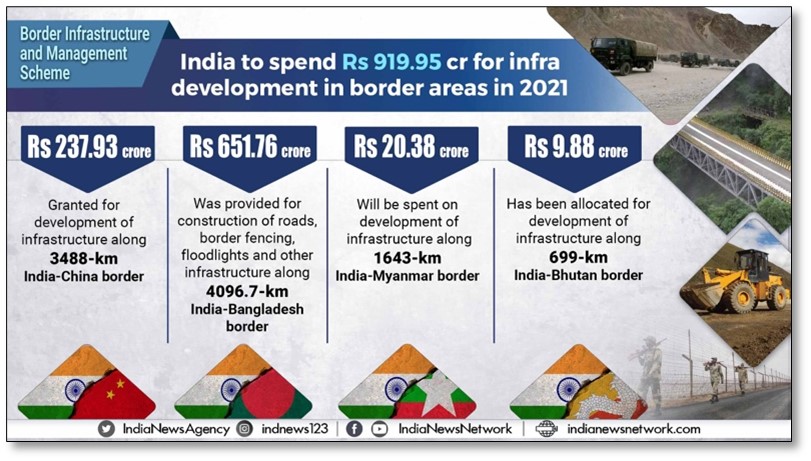Wednesday, 2nd March 2022
GDP Second Advance Estimates
In News
The Ministry of Statistics and Programme Implementation (MoSPI) released the Second Advance Estimates (SAEs) of GDP for the current financial year projected at 8.9%.
What are Advance Estimates?
- In India, advance estimates of GDP are published before or at the end of a financial year by the National Statistics Office (NSO) based on all the information then available.
- NSO is the statistics wing of MoSPI.
- First Advance Estimates (FAE) of GDP are typically published at the end of the first week of January, long before the financial year (April to March) is over.
- They are the GDP estimates that the Union Finance Ministry uses to decide the next financial year’s budget allocations.
- This is followed by the Second Advance Estimates (SAE) in February after the Third Quarter (Q3) data are available.
- For each financial year the GDP estimates go through several rounds of revisions.
- Each revision benefits from more data, making the GDP estimates more accurate and robust.
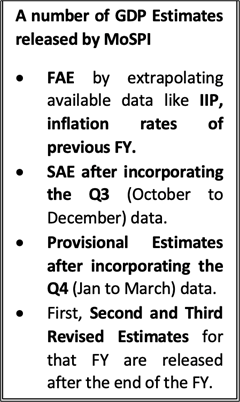
Highlight in the SAE 2022
- At 8.9% it is a downward revision from the 9.2% economic growth projected in FAE by MoSPI.
- Economists believe these figures still carry risks like elevated crude prices. So FY22 GDP may be lower than estimated by SAE.
- The figures further strengthen the argument that the economic recovery in FY22, after the slump in FY21 due to Covid-19, is good enough for overall GDP to scale back the pre-Covid level.
- The growth rates of GDP drivers from the demand side — namely, private final consumption expenditure (PFCE), government final consumption expenditure (GFCE) and gross fixed capital formation (GFCF) — have undergone a change.
- In the FAE, recovery was driven by higher investments, as evidenced by the spike in GFCF.
- According to SAE, PFCE and per capita PFCE (read expenditure) have jumped. GFCE and GFCF show a commensurate decline in SAEs over the FAE figures.
- Overall, all components are above the pre-Covid level and they are being led by private demand, which augurs well for the future.
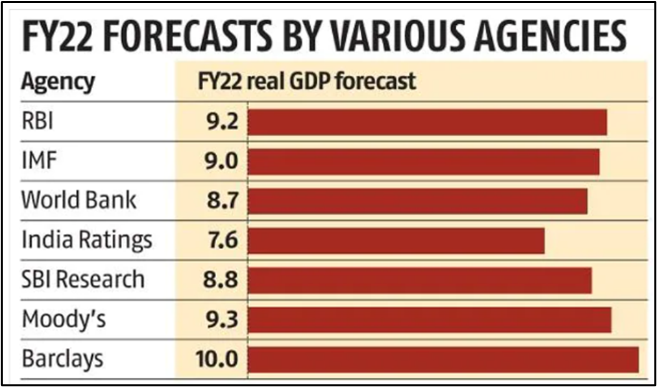
How the estimates affect the economy?
- With the pandemic not abating anytime soon, the impact of the ongoing geopolitical tensions between Russia and Ukraine needs to be closely monitored.
- The unfavourable combination of poor growth and high inflation also means the Reserve Bank of India (RBI) could continue to focus on boosting growth rather than fight inflation immediately.
- RBI has been following an accommodative policy to revive and sustain growth on a durable basis and at the same time ensure that inflation remains within its target since the pandemic began.
- During such uncertain times, revisions are extremely important. As more data is added with time from different sectors, the GDP figures will keep on changing.
- Experts believe that growth revisions for the pandemic year such as FY21 should be viewed carefully and the exogenous shock, which the economy has faced, cannot be modelled/factored in any estimation process.
For articles related to this topic, refer:
https://edukemy.com/current-affairs/gazette/2022-02-02/budget-2022-23
https://edukemy.com/current-affairs/gazette/2022-02-02/budget-2022-23-analysis
https://edukemy.com/current-affairs/gazette/2022-02-23/governments-capex-push
Sources:
Indian dependence for Russia’s weapons
In News
In the wake of Ukrainian crisis, India needs to ponder on the long-term implications of its dependence on Russian weapons
About the News
- In this aftermath, India has been trying to balance its relationships between United States & Western nations on one side, and the historically deep and strategic ties with Russia on the other.
- With sanctions imposed by the United States and other countries on Russia, India’s slowly shifting stand are going to have a long-term impact, most significantly on the decades old defence trade between the two.
What are the major issues?
- Dependence: The legacy of buying weapons from Russia has made India somewhat dependent on it, and even though India has tried to expand the base of countries from which it buys new military systems, Russian-origin weapons still have the lion’s share of as high as 85 per cent.
- Diversification: Over the last few years there has been a conscious effort by India to expand the weapons platform bases from Russia to other countries besides exploring possibilities domestically as well.
- Threat of Sanctions: Major deals especially S-400 Triumf has been under the threat of fresh round of sanctions on Russia post the Ukraine invasion.
- Price extrapolation: In most defence deals, bureaucratic delays due to complex and lengthy procurement processes have led to increase in deal amount burden for India.
- Threat of leverage: Becoming too much reliant on any single nation can give leverage t one nation with threat of exploitation by that nation.
What are the major types of weapons delivered by Russia?
- S-400 Triumpf: India has signed a deal to buy five units of S-400 Triumf air-defence system for around $5 billion. It is among the most advanced in the world, and India has placed the first unit at an Indian Air Force base in Punjab.
- AK Rifles: India and Russia have signed a deal to manufacture around 6 lakh AK 203 rifles at a factory in
- P75-I project: Russia has proposed to make six AIP-powered conventional submarines for the Indian Navy under the, along with four other international bidders. The final call is yet to be taken.
- Submarines: The first submarine India ever got was a Soviet Foxtrot Class submarine which entered Indian service in 1967 as INS Kalvari. Of the total 16 conventional diesel-electric submarines with the Indian Navy, eight are Kilo class, of Soviet Russia is also expected to lease two nuclear-ballistic submarines, Chakra 3 and Chakra 4, the first of which is expected to be delivered by 2025.
- Aircraft carrier: The only aircraft carrier in service with India, INS Vikramaditya is a Soviet-made Kiev-class vessel that came into service for the Indian Navy in 2013.
- BrahMos missile: India’s missile programme and BrahMos missile has been developed with significant help from Russia or the Soviets earlier.
- Fighter jets: The Indian Air Force’s 667-plane fighter ground attack (FGA) fleet is 71 per cent Russian-origin (39 per cent Su-30s, 22 per cent MiG-21s, 9 per cent MiG-29s). All six of the service’s air tankers are Russian-made Il-78s.
- Tanks: Indian Army’s main battle tank force is composed predominantly of Russian T-72M1 (66 per cent) and T-90S (30 per cent).
- Guided missile destroyers: Four of the Navy’s 10 guided-missile destroyers are Russian Kashin class, and 6 of its 17 frigates are Russian Talwar class.
For articles related to this topic, refer:
https://edukemy.com/current-affairs/gazette/2021-12-10/sipri-report-on-arms-trade-in-2020
https://edukemy.com/current-affairs/gazette/2021-12-10/modernization-of-indian-armed-forces
https://edukemy.com/current-affairs/gazette/2021-12-06/weaponisation-of-trade
https://edukemy.com/current-affairs/gazette/2021-07-09/integrated-theatre-command
Sources:
Montreux Convention
In News
Turkey is set to implement an international convention on naval passage to limit the movement of Russian warships between the Mediterranean Sea and the Black Sea.
About the News
- Turkey, intends to activate the Montreux Convention and ban Russian war vessels from entering the Black Sea through the Bosporus and Dardanelles straits in the backdrop of the current war situation in Ukraine.
- The Bosporus and Dardanelles straits, also known as the Turkish Straits or the Black Sea Straits, connect the Aegean Sea and the Black Sea via the Sea of Marmara.
- It is the only passage through which the Black Sea ports can access the Mediterranean and beyond.
- Over 3 million barrels of oil, about 3% of the daily global supply, mostly produced in Russia, Azerbaijan, and Kazakhstan, pass through this waterway every day. The route also ships large amounts of iron, steel, and agricultural products from the Black Sea coast to Europe and the rest of the world.
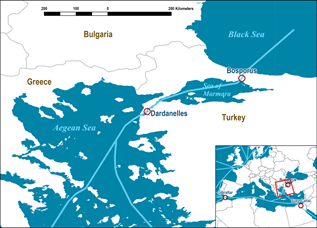
How do the straits operate and what say does Turkey have?
- According to the 1936 Montreux Convention on the Regime of the Straits, referred to as the Montreux Convention, Turkey has control over both the Bosporus and Dardanelles straits.
- However, according to Article 19 of the treaty, warships can return to their original bases through the passage and Turkey cannot prevent it.
- For example, a Russian fleet registered in the Black Sea but currently located in the Mediterranean Sea, is allowed to pass through the Bosporus and Dardanelles straits and return to its base and vice versa. If this warship is to go to the base in the country that is a party to the war, then this passage cannot be prevented.
- There should be no abuse and the ships returning to their bases should not be involved in a war after saying it will go back to the base.
- Whether the ship has the right to pass through the Straits or not, falls under the authority of the state that owns the ships. Therefore, an alternate possible way for Russia to exploit the Montreux Convention, would be to reassign some of its vessels to the Black Sea.
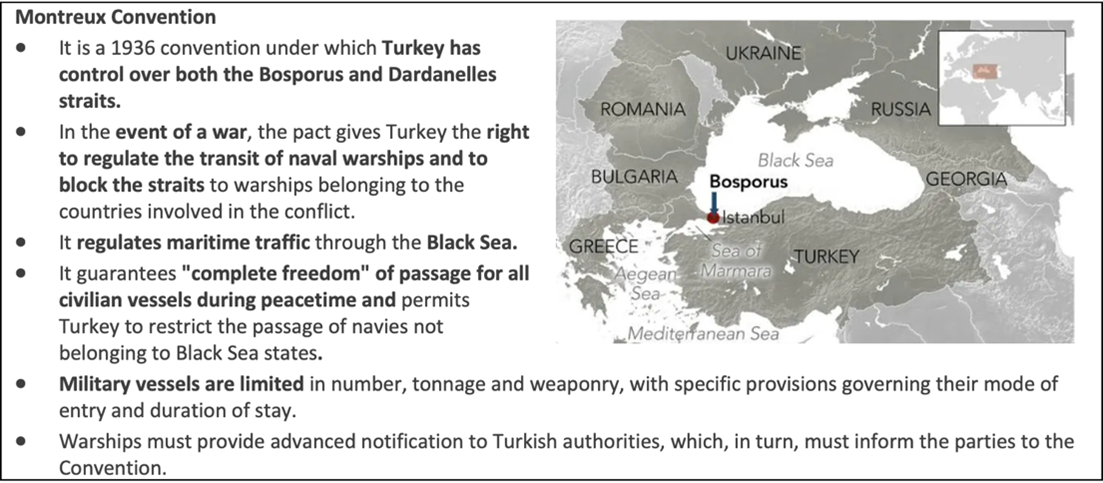
For articles related to this topic, refer:
https://edukemy.com/current-affairs/gazette/2021-11-26/the-non-aligned-movement-nam-at-60
https://edukemy.com/current-affairs/gazette/2021-10-13/indias-nuclear-doctrine
https://edukemy.com/current-affairs/gazette/2021-06-25/antarctic-treaty-system
Source:
- What is the Montreux Convention and can Turkey use it to block Russian warships?
- How a 1936 treaty could force Turkey to take sides in the Ukraine war
Picture source:
First Government owned company
On March 2, 1952, Indian Prime Minister at the time, Jawahar Lal Nehru formally inaugurated the Ammonium Sulphate of Sindri factory. It was the first Government-owned company. It came into being in December 1951 as the first Public Sector Company in India. In his inauguration speech, Jawahar Lal Nehru said that he was inaugurating a temple of modern India. Sindri Fertilizer Factory went on stream with the Power Plant; the Gas Plant; the Ammonia Synthesis Plant; and the Sulphate Plant and produced Ammonium Sulphate at 960 tons per day.

Sources:
LIFE - Lifestyle for environment
In News
In November 2021, India’s PM proposed a One-Word Movement in the context of climate: LIFE - Lifestyle for Environment, at the COP 26 in Glasgow.
What is Lifestyle for Environment?
- This movement calls for coming together with collective participation, to take lifestyle for environment forward as a campaign and as a mass movement for environmentally conscious life style in a manner that revolutionizes many sectors and diverse areas such as fishing, agriculture, wellness, dietary choices, packaging, housing, hospitality, tourism, clothing, fashion, water management and energy.
- The idea is based on mindful and deliberate utilisation of resources, instead of mindless and destructive consumption.
- The idea of ‘LIFE’ is to be taken ahead as a mass campaign to nudge the people to adopt environment conscious lifestyles.
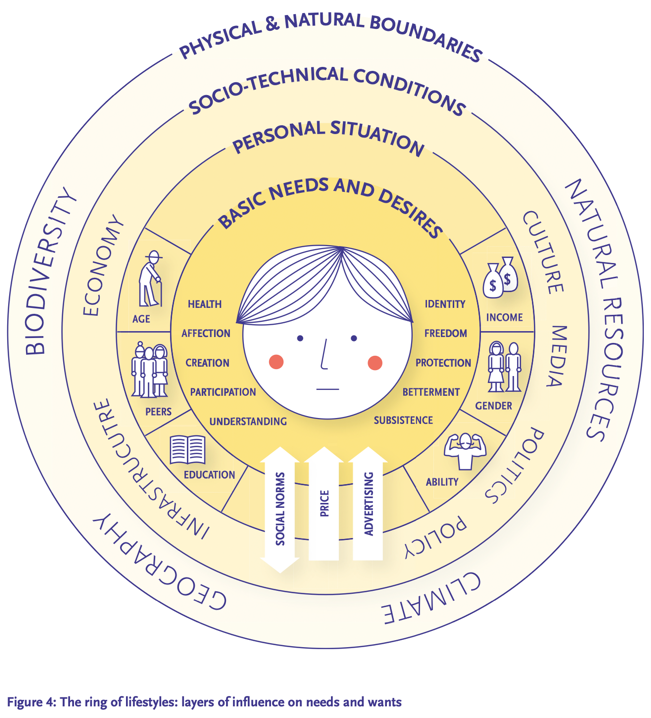
Components of LIFE
- From dispose economy to circular economy: In a linear/dispose economy we mine raw materials that we process into a product that is thrown away after use. In a circular economy, we close the cycles of all these raw materials. It aims to increase the lifecycle of goods through reuse, recycling and repairs.
- 3Ps – Pro Planet People: People and planet are interconnected. Life as we know today cannot exist if either are destroyed. The aim is to encourage people to lead the lifestyle having a smaller carbon footprint, leading to a more sustainable use of the environment.
- Eliminating/ Reducing throw away culture: Under throwaway culture, economy is strongly influenced by consumerism. It features overconsumption and a preference for short-lived products, which maximise profit, rather than creating durable goods that don't need constant replacing.
- One World: Climate change is a global phenomenon. No individual country has the ability to solve this problem alone. Thus, there is need for international cooperation and coordination to better tackle the challenge.
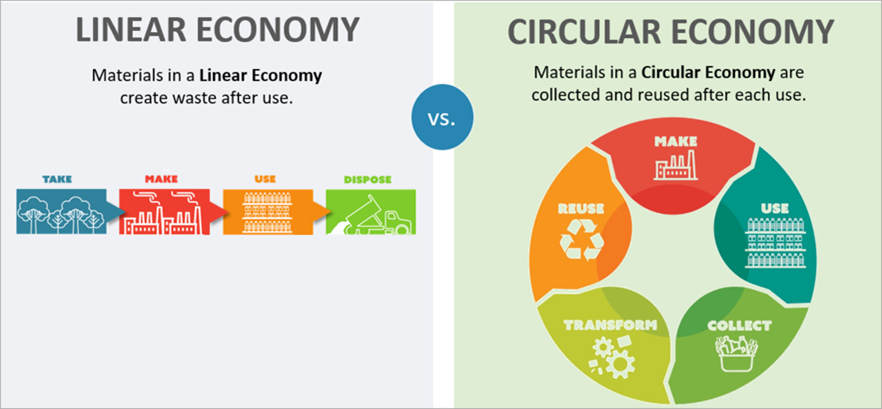

Drivers of Lifestyle of a person/ Society
- Income level: This is one of the strongest lifestyle indicators and drivers of consumption. Also, there is compounded social pressure to maintain lifestyle levels once adopted.
- Values: Many consider values as the foundation of lifestyle decisions as people tend to consume to fulfil value-laden objectives. Values can be at the personal or broader cultural or ethical levels.
- Ability: People’s abilities are influenced by many things e.g. age, geography, climatic conditions, which in turn affect lifestyle decisions.
- Awareness: Awareness of consumption impacts, at the individual and collective levels, can shape choices. Awareness can have a multiplier effect.
- Knowledge: The availability (or the lack) of knowledge and information on products, services, and alternative options can often encourage or hinder lifestyles choices.
- Social norms and peers: Our lifestyles are heavily influenced by those around us: family background, social circles, colleague expectations, professional decorum and social practices
- Media: The media with its far reach into our lives is one of the strongest influences on values, social norms and lifestyles, spreading and accelerating the social norms of consumerism.
- Market prices: Market prices determine who can afford market options. When more sustainable products or services are priced higher than the less sustainable alternatives, the sustainable option is less competitive
- Technology: Characteristics such as complexity, resource efficiency, indigenousness, and affordability influence the uptake and use of technologies.
- Policies and institutional frameworks: These 2 have a powerful influence on all stakeholders and lifestyle directions. Hard (e.g. penalties and subsidies) and soft (e.g. nudging and voluntary standards) policy instruments can shift the entire consumption architecture.
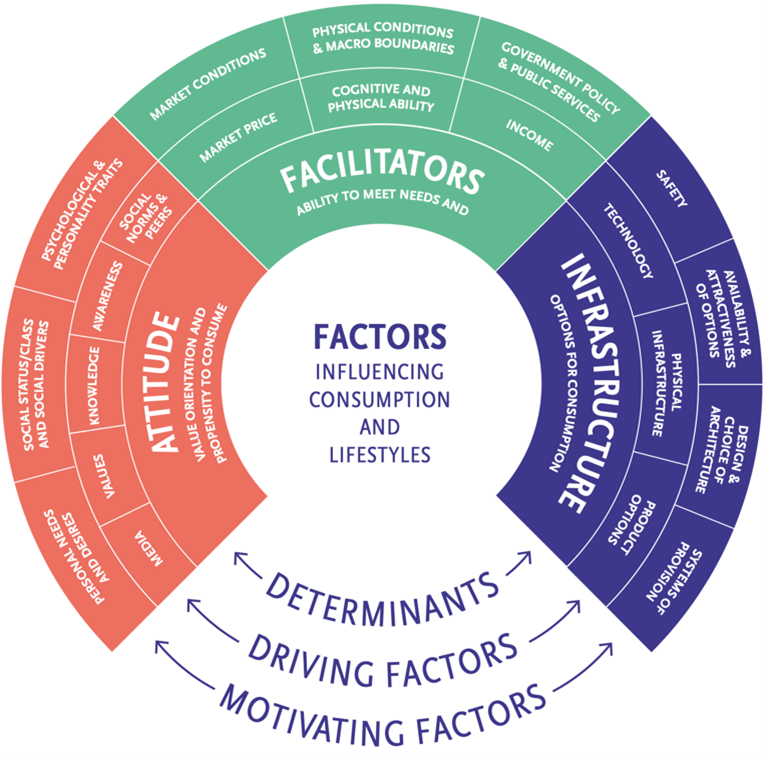
Strategies for Implementing LIFE
- The REDuse framework: The Refuse, Effuse and Diffuse (REDuse) framework, supports bottom-up approaches, encourages programmes and actions that directly empower individuals and households in their daily lives (and, indirectly, communities), enabling them to understand, create and/or choose the more sustainable lifestyle options.
- The Attitude-Facilitator-Infrastructure (AFI) framework is a top-down approach to support government policy, business models, institutional arrangements, and actions that set the conditions necessary for sustainable lifestyles to thrive.
- Attitude – pro-sustainability value orientation
- Facilitators/ Access – institutional arrangements and enablers
- Sustainability infrastructure – the hardware and systems of provision

India as a leader in climate change
- Coalition for Disaster Resilience Infrastructure: Indian initiative to promote joint action in the field of building disaster resilient infrastructure in the small island states.
- Green Grids initiative: One sun, one world, one grid – an initiative of India and the UK to create an interconnected global power grid for reliable, resilient and affordable supply of clean energy for all.
- International Solar Alliance: Global alliance initiated by India with France to promote research to develop low cost solar power. The Benefits of this research can be reaped by all the members.
- India is the only country among the G20 members to consistently bag one of the top positions in the Climate Transparency Report.
Conclusion: One crucial step to support lifestyle for environment (LIFE) requires understanding the patterns of different types of lifestyles – known as lifestyle segmentation. Each lifestyle segment has and manifests distinct values, preferences, and practices in areas such as fashion, use of language, and leisure activities. There is a need for countries, regions and cities to conduct social-ecological segmentation to design targeted interventions solutions and better responses.
For articles related to this topic, refer:
https://edukemy.com/current-affairs/gazette/2021-08-26/solid-waste-management
https://edukemy.com/current-affairs/gazette/2021-08-27/informal-sector-in-waste-management
https://edukemy.com/current-affairs/gazette/2022-02-17/climate-smart-agriculture
https://edukemy.com/current-affairs/gazette/2021-10-27/health-infrastructure
https://edukemy.com/current-affairs/gazette/2021-06-08/ethanol-blending
https://edukemy.com/current-affairs/gazette/2021-11-17/sustainable-transport
https://edukemy.com/current-affairs/gazette/2022-02-22/agreement-on-blue-economy
https://edukemy.com/current-affairs/gazette/2021-06-17/deep-ocean-mission
Question: Discuss the idea of Lifestyle for Environment proposed by India at COP 26.
Sources:
- PM Modi on climate: what is 'Lifestyle for Environment'?:
- PIB Sansad Tv – Perspective episode – COP 26 – need for climate equity The Glasgow summit on climate change: What has it achieved?:
- India has shown what climate leadership looks like:
- Pro Planet People': PM Modi Invokes 3Ps from COP26, Talks About Sustainable Lifestyle at Global Summit:
- A framework for shaping sustainable lifestyles:
- Indian Culture and Lifestyle for Environment Conservation: a Path Towards Sustainable Development:
Perini dance performance
This is image of Perini dance performance. It was recently performed on the occasion of Mahashivratri. This classical dance uses 'Prerana' which means inspiration and is dedicated to Lord Shiva. It is one of the dance forms from Telangana. Perini is a form of Indian dance which was lost in timeline and which was recreated and re-established in 20th century by Padmasri Dr. Nataraja Ramakrishna. Perini Shiva Tandavam is the stimulator to activate the dormant dynamism in human. Perini is the slang form of the word ‘prerana’ which means stimulation. It is said to be the only form of scientifically composed male warrior dance and a form of traditional Indian dance with tala, gati, yati vinyasa. It is a kind of ritual also where one can offer prayers to Lord Shiva and it is said to activate the kundalini.

Sources:
IVFRT scheme
- Context: The Centre has recently approved the continuation of the Immigration Visa Foreigners Registration Tracking (IVFRT) Scheme for a period of five years from April 2021 to March 2026.
- IVFRT scheme seeks to interlink and optimise functions relating to immigration, visa issuance, registration of foreigners and tracking of their movements in India.
- It covers 192 Indian Missions across the globe, 108 Immigration Check Posts (ICPs) in India, 12 Foreigners Regional Registration Officers (FRROs) and offices and), Superintendents of Police (SPs)/Deputy Commissioners of Police (DCPs) across the country.
- With the implementation of the scheme,
- the number of Visa and OCI cards issued has increased from 44.43 lakh in 2014 to 64.59 lakh in 2019 at a compounded annual growth rate (CAGR) of 7.7%.
- Average visa processing time of 15 to 30 days has been reduced to a maximum of 72 hours in e-visas, with 95% of e-visas issued within 24 hours.
- International traffic to and from India grew from 3.71 crore to 7.5 crore during last 10 years at a CAGR of 7.2%
- Thus the scheme will provide a secure and integrated service delivery framework that facilitates legitimate travellers while strengthening national security.

Source:
Deocha Pachami Coal Block
- Context: The West Bengal government has recently revised the compensation package for those losing their land for Deocha Pachami mega coal project.
- Deocha Panchami coal mine or Deocha Panchami coal block is a coal mine situated in Birbhum district of West Bengal.
- There are 12 villages in the area with around 4,314 households with a population of over 21,000 that includes 3,601 Scheduled Caste (SC) and 9,034 Scheduled Tribe (ST).
- The block has a reserve of around 1,198 million tonnes of coal and 1,400 million cubic meter basalt (black stone).
- Spread over 31 sq. km., it is considered to be the largest block in the country.
- The mega coal project is expected to generate employment to about one lakh people.

Source:
International Intellectual Property Index
- Context: India has improved its overall IP score on the International Intellectual Property (IIP) Index.
- The IIP Index evaluates the IP framework in each economy that has the most effective IP systems across 50 unique indicators.
- The indicators create a snapshot of an economy’s overall IP ecosystem and span nine categories of protection that include patents, copyrights, trademarks, design rights, trade secrets, commercialization of IP assets, enforcement, systemic efficiency, and membership and ratification of international treaties.
- India's overall IP score has increased from 40% to 38.64% and the country is ranked 43 out of 55 countries.
- The United States topped the index, followed by the UK, Germany, Sweden and France.

Source:
- Intellectual Property Key to Economic Recovery and Defeating Coronavirus, New U.S. Chamber Report Shows
- India's overall ranking on IP protection improves, says USCC report
Picture source:
Watts on the Moon Challenge
- Context: NASA has recently opened the second phase of the Lunar Power Prize Competition- the Watts on the Moon Challenge.
- The Watts on the Moon Challenge is a $5 million, two-phase competition focused on addressing critical gaps in lunar surface power systems, specifically related to power transmission and energy storage.
- The challenge is in the backdrop of NASA seeking solutions that can be designed, built, and tested in simulated lunar conditions and are well-positioned to progress towards flight readiness and future operation on the lunar surface.
- The first phase of the challenge presented a mission scenario with three mission activities focused on energy distribution, management, or storage solution.
- The current second phase presents competitors with a conceptual power load profile and environmental conditions where teams must design and build a solution that delivers the required power, optimizes mass and efficiency and is demonstrable within the challenge timeline.
- Eligible participants are individuals who are S. citizens or permanent residents of the United States, 18 years of age or older and organizations that are an entity incorporated in and that are maintaining a primary place of business in the United States.
- NASA will award a total prize purse of $4.5Mto winners over three levels.
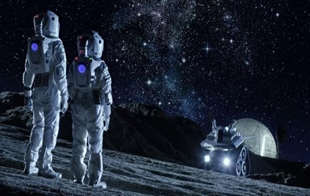
Source:
- NASA Opens Second Phase of $5 Million Lunar Power Prize Competition
- HeroX Launches Phase 2 of NASA's "Watts on the Moon" to Source Power Transmission and Energy Storage Solutions for Lunar Activities
Picture source:
The Ukraine war, India and a stand of non-alignment: TH
Essence: Russian invasion of Ukraine has put India in a difficult situation. India has a growing relationship with the US but at the same time we cannot let go of our long trusted relationship with Russia. Both Russia and Ukraine have widely recognized national interests at stake but both could have acted differently to avoid this war. But there is no doubt that by violating Ukraine’s sovereignty Russia has violated international law.
Considering all this, India’s stand has been rightly guided by the classical Nehruvian policy of non-alignment. However, if war will lead to increased civilian casualties, it will become very difficult for India to remain neutral.
Why should you read this article?
- To make sense of India’s decision to stay neutral in the Ukraine crisis.
- To understand how realpolitik drives a nation's decision making in International politics.
Source:
Planning for resilience in a warming world: IE
Essence: The article discusses the 6th assessment report on the consequences of climate change and its implications on vulnerability and adaptation by the Intergovernmental Panel on Climate Change (IPCC). According to the report, Indian people are among the most susceptible and vulnerable to climate-related dangers and calamities. According to the paper, urbanisation processes have created vulnerability and exposure, which, when paired with climate change threats such as heat waves, flooding, and other natural disasters, could become life-threatening, wreaking havoc on the Indian economy. The existing adaptation methods are mostly focused on quick fixes and catastrophe management, but they must shift to long-term planning for resilient communities. India must reintroduce its traditional adaptation strategies. To summarise, adaptation in cities and other metropolitan regions, where the majority of the world's population resides, will be primarily dependent on the resilience of environmental, social, and physical infrastructure. Cities in India face a trade-off between long-term planning to achieve net-zero emissions and quick responses to safeguard cities from climate-related hazards and dangers.
Why should you read this article?
- To comprehend the impact of climate change on India, as well as the shortcomings of current adaptation measures.
- To determine what actions may be made to better protect cities from climate-related threats and dangers.
Source:
Russia’s Hybrid Warfare Strategy: From Crimea to Ukraine- ORF
Essence: The editorial focuses on a series of innovative and integrated techno-military measures taken by Russia in its past and present endeavors. The hybrid war played by Russia has involved disinformation, propaganda, use of proxies, covert operations, intelligence gathering, cyber warfare, threat of nuclear warfare, along with the invasion by “peacekeeping force”. Integrating these forces results in hybrid war, which Russia has carried out in Georgia, Estonia, Crimea, Ukraine, etc.
The reaction time to such blitz is so small that it takes a while to understand the jointness of events and forge a retaliation. By the time other stakeholders prepare for action, the perpetrator already wins the battle.
Why should you read this article?
To understand the components of hybrid warfare conducted by Russia lately.
To know the impacts of such warfare on the nearby countries.
Source:
The Young Forest Girl
Background
- Forests play a vital role in our lives by providing food, fodder, oxygen, etc.
- Prasiddhi Singh from Chennai understood its importance at a tender age of 4 and since then there has been no looking back for her.
About the Young Forester
- When Prasiddhi was 4 years old, Chennai was hit Cyclone Vardah. The damage by the cyclone concerned her about losing her favourite tree.
- She started a drive of planting trees in her locality, which sums up to more than thousands.
- She has created about 20 mini forests consisting of 28,500 fruit trees, which were planted by her own hands.
- Her foundation named Prasiddhi Forest Foundation is working towards creating awareness about green cover and active recycling.
- The foundation is aimed at planting one-lakh trees by the end of 2022, with the help of the eco-warriors working together in the organisation.

Quote: “The forest is a peculiar organism of unlimited kindness and benevolence that makes no demands for its sustenance and extends generously the products of its life activity; it affords protection to all beings, offering shade even to the axe-man who destroys it.” -Gautama Buddha
Source:
Share the article
Get Latest Updates on Offers, Event dates, and free Mentorship sessions.

Get in touch with our Expert Academic Counsellors 👋
FAQs
UPSC Daily Current Affairs focuses on learning current events on a daily basis. An aspirant needs to study regular and updated information about current events, news, and relevant topics that are important for UPSC aspirants. It covers national and international affairs, government policies, socio-economic issues, science and technology advancements, and more.
UPSC Daily Current Affairs provides aspirants with a concise and comprehensive overview of the latest happenings and developments across various fields. It helps aspirants stay updated with current affairs and provides them with valuable insights and analysis, which are essential for answering questions in the UPSC examinations. It enhances their knowledge, analytical skills, and ability to connect current affairs with the UPSC syllabus.
UPSC Daily Current Affairs covers a wide range of topics, including politics, economics, science and technology, environment, social issues, governance, international relations, and more. It offers news summaries, in-depth analyses, editorials, opinion pieces, and relevant study materials. It also provides practice questions and quizzes to help aspirants test their understanding of current affairs.
Edukemy's UPSC Daily Current Affairs can be accessed through:
- UPSC Daily Current Affairs can be accessed through Current Affairs tab at the top of the Main Page of Edukemy.
- Edukemy Mobile app: The Daily Current Affairs can also be access through Edukemy Mobile App.
- Social media: Follow Edukemy’s official social media accounts or pages that provide UPSC Daily Current Affairs updates, including Facebook, Twitter, or Telegram channels.



